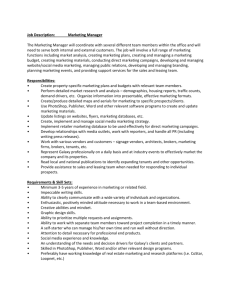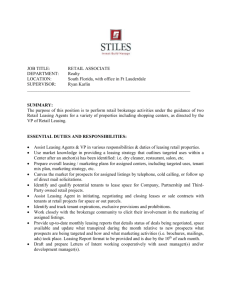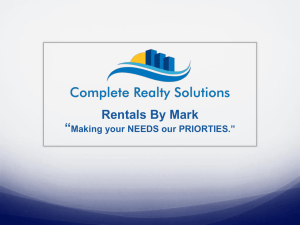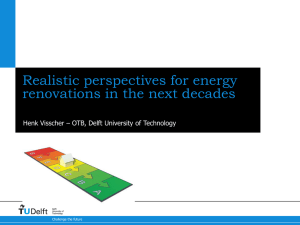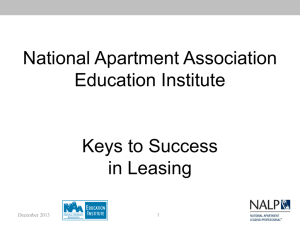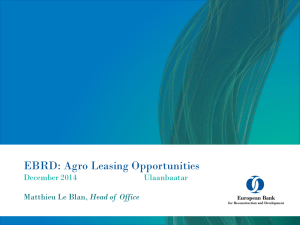Steel Street - Manage Decisions
advertisement
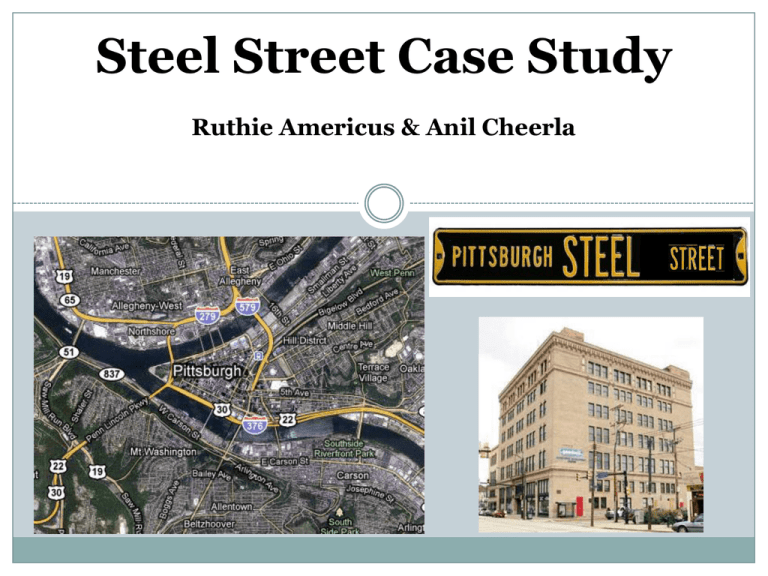
Steel Street Case Study Ruthie Americus & Anil Cheerla Case Facts Vincent Colmo (Ex HBS) & cousin Daniel Delconte – partnered to form River Triangle Associates, a profitable RE investment firm specializing in buying apartment bldgs & strip malls below replacement costs, rehab/re-position them and sell them for strong returns. Average returns to investors – 14% Rents 30% below new construction Vincent was responsible for buying, renovating and maintaining properties while Daniel managed finances and investor relationships Project selection based on: Returns, Renovations within 6-9 months to avoid carrying costs, Bypass city regulations & Target middle-income market With commercial RE unwinding, RTA focused on office properties in Pittsburgh’s Southside, adjacent to CBD – a hip neighborhood known for vibrant night life, shopping, cafes and business incubation. Overview of the Space 6 story; 1920 building located in Southside 5 floors of office space; 1 floor (ground floor) of retail space 49,000 gross sq. ft. Estimated renovation costs are $69/sq. ft. Hope to increase rents from $8/sq. ft. to $15/sq. ft. Pros/Cons Pros Cons • Steel Street renovation is only • This is River Triangle expected to costs $69/sq. ft. as opposed to $150/sq. ft. for new construction • Building is in desirable location and rents will increase after renovations • Plan to accrue rent during renovation phase Associates first office space renovation (they are only experienced at residential renovations) • They will need to continue renting some of the space while completing construction (which tenants might not like) Strategic Advantages of Steel Street Located in Southside, a hip neighborhood with many startups Limited space availability for new development Potential to attract large new employers – business office space combined with retail Proximity to a new popular retail complex Replacement cost $69/sq.ft vs. $150 for new office construction Market wise – Pittsburgh had a diversified economic base, low unemployment, no overcapacity, insulation from RE downturn & growth prospects Renovation Schedule & Funding Sources What went wrong? Causes First, the cousins chose an architect that had high fees. Also she thought their original budget was too small to work with The architect and the contractors have never worked together before and there is some large disconnect between the architect’s vision for the building and the contractor’s work style Effects The architect was getting behind schedule and her designs were being repeated reworked and costing much more than the original estimates The leasing of the space was not going well because prospective tenants wanted to see the finished space before signing a lease The city building inspector walked through the site and was not pleased with the safety of the conditions that the contractor was working within What is next… After owning the property for almost 1 and months of construction, in September of 2009 what is next… 1- Find a new construction team 2- Recruit new investors to cover budget shortfalls 3- Ask hedge fund to convert debt into equity 4- Contribute from their personal finances 5- Give incentives to leasing agents and tenants 6- Lose some green elements to the building Option 1 Option 1: Find a new construction team Not an option since hiring a new contractor would result in: Additional costs Construction delay Incoherence with existing work already done Threat of losing at least ½ year job with additional modifications to project scope and schedule Also, being a lump sum contract, Harper & Polowski agreed for a fixed price, so it is in the best interests of RTA to continue working with the existing contractor. Option 2 Option 2: Recruit new investors to cover budget shortfalls Ruled out because of the following factors: Credit markets were in turmoil Liquidity was lacking The MBS markets were shrinking Sponsors did not have office building experience Current project situation is not helping anyway Option 3 Option 3: Ask hedge fund to convert debt into equity Hedge funds specialize in short-term trading strategies, are open-ended vehicles permitting both periodic subscriptions and redemptions. So holding a illiquid asset will go against their business strategy. May even argue that given low yield, low volatile market conditions, Harvard group may find this equity return attractive. Option 4 Option 4: Contribute from their personal finances As per the agreement terms, RTA were to extend financing to the partnership of up to $200,000 as an uncollateralized 10% interest bearing loan. Personal B/S shows that the cousins can part with capital for additional overruns, but given the risks involved, our opinion was that they would not make any new additional investments. Initial equity of $563,885 would result in 1,284,886 after 5 years Option 5 Option 5: Give incentives to leasing agents and tenants To compensate for the leasing agent’s slow movement, the cousins will provide a $20,000 signing bonus to any brokers who sign leases with tenants for over 5,000 sq. ft. This added bonus will only decrease the IRR from 28% to 26%, and will hopefully drastically improve the leasing situation. Good option, but may have to reduce their returns overall. Will work to mitigate vacancy by having large, clients sign up long-term leases with sound credit Option 6 Option 6: Lose some green elements to the building May not be a wise choice as the bldg may not appeal to new tenants or even existing lease renewals. Cannot justify higher rental rates of $15 psf. Will not bring in the energy efficiencies expected May not compete with other “green” properties in the market. Original Pro Forma Levered Returns Initial Outlay Initial Equity $ (563,885) Building Renovations $ (794,000) 2009 $ 71,787 Annual Cash Flow 2010 $ 197,256 2011 $ 232,108 2012 $ 232,108 $ 232,108 $ 3,175,871 Sales Proceeds - Mortgage Repayment Total Cash Flows $ (1,357,885) $ 71,787 Annual ROE IRR $ 197,256 5.29% 28.16% 2013 $ 232,108 14.53% $ 232,108 17.09% $ 3,407,979 17.09% 17.09% Modified Pro Form with Leasing Bonus Levered Returns Initial Outlay 2009 2010 2011 2012 2013 $ Initial Equity Building Renovations (563,885) $ (794,000) $ Annual Cash Flow $ 71,787 $ 37,256 $ 72,108 $ 232,108 232,108 $ 3,175,8 71 Sales Proceeds - Mortgage Repayment $ $ Total Cash Flows $ (1,357,885) Annual ROE IRR $ 71,787 5.29% 24.44% $ 37,256 2.74% $ 72,108 232,108 5.31% 17.09% 3,407,9 79 17.09% Looking back: Issues at Stake • Issues with re-positioning a property • Problems with development teams • Impact of weak credit markets on RE financing • Cost overruns and poor management • Volatile markets – impact on rental/vacancy rates • Importance of risk assessment, planning and mitigation • Lack of expertise in RE domain – Office properties What-if analysis To understand the impact on RTA returns, we did sensitivity analysis on the following: If vacancy rates fluctuate – If rental rates vary If additional leasing commissions of $20,000 are provided If costs escalate beyond control If existing retail tenant breaks lease and collects $25,000 as damages If one of the Banks/Hedge funds withdraws financing Vacancy & Rental rates Vacancy rates vary Rental rates vary LC & Increasing Equity Brokers incentivized Cumulative impact (LC+Eq) Questions???
